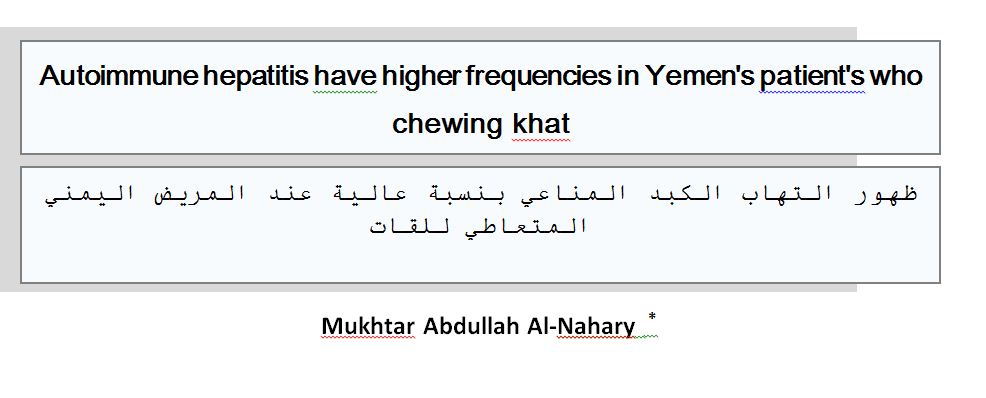Autoimmune hepatitis have higher frequencies in Yemen's patient's who chewing khat Mukhtar Abdullah Al-Nahary *
Main Article Content
Abstract
Abstract.
The khat tree is a common plant that grows in Yemen and East Africa (East and West Harge regions in Ethiopia) and has many health, social and economic damages. Because of the lack of awareness in this field and the lack of research, we find that this phenomenon is difficult to control, and we find that people who consume khat suffer from many serious health problems and may lead to death. One of these risks is the harmful effects of consuming khat on the human liver. This paper presents the damage that the khat tree causes to humans and that it is a major cause of hepatitis and autoimmune liver disease as autoantibodies to ANA and ASMA have been shown in patients without chronic liver disease. Clinical examinations, blood and urine tests, and abdominal ultrasound were conducted for a group of 420 patients between the ages of 18-45 years from different cities of Taiz, Al-Turbah, Lahj and their villages in the Republic of Yemen. The immunosuppressant drug prednisalone (0.5 mg/kg/day), Ursochol 250 mg (10 mg/kg/day) and Livbest tab (2 tablets twice daily) have been suggested and given excellent results for all patients. After the treatment, according to the duration suggested in the research, three weeks and continuing for one month in order for all the enzymes of the liver to become normal. After that, treatment was stopped completely and also abstained for three months from consuming khat, where the percentage of complete recovery was 315 out of 420, except for 80 cases with a weak rise in liver enzymes and 20 cases where an anti-smooth muscle antibody (ASMA) remained positive without symptoms and 5 cases of antinuclear antibodies (ANA) positive without symptoms. Through the results, it became clear that the treatments proposed in the research have a good effect in treating such cases and can be stopped after a liver function improves as long as khat chewing is abstained.
Keywords: Khat, Autoantibodies, autoimmune hepatitis, ANA, ASMA.
Article Details
References
Reference
Pehek EA, Schechter MD, Yamamoto BK. Effects of cathinone and amphetamine on the neurochemistry of dopamine in vivo. Neuropharmacology29(12):1171-6, 1990.
Giannini A, Castellani S. A manic-like psychosis due tockhat. J Toxicol Clin Toxicol,19(5):455-9, 1982.
Critchlow S, Seifert R. Khat induced paranoid psychosis. Br J Psychiatry;150;247-9, 1987.
McLaren P. Khat psychosis. Br J Psychiatry 1987;150:712-3.
Yousef G, Huq Z, Lambert T. Khat chewing as a cause of psychosis. Bri J Hosp Med (Lond),54(7):322-6, 1995.
Kalix P. Catha edulis, a plant that has amphetamine effects. Pharm World Sci, 18(2):69-73, 1996.
Al-Motarreb A, Baker K, Broadley KJ. Khat: Pharmacological and medical aspects and its social use in Yemen. PhytotherapyRes,16(5):403-13, 2002a.
Toennes, S.W.; Harder, S.; Schramm, M.; Niess, C.; Kauert, G.F. Pharmacokinetics of cathinone, cathine and norephedrine after the chewing of khat leaves. Br. J. Clin. Pharmacol, 56, 125-130, 2003.
Widler, P.; Mathys, K.; Brenneisen, R.; Kalix, P.; Fisch, H.-U. Pharmacodynamics and pharmacokinetics of khat: A controlled study. Clin. Pharmacol. Ther 55, 556-562, 1994.
Gunaid AA, Sumairi AA, Shidrawi RG, Al-Hanaki A, Al-Haimi M, Al-Absi S, Al-Huribi MA, Qirbi AA, Al-Awlagi S, El-Guneid AM, Shousha S, Murray-Lyon IM. Oesophageal and gastric carcinoma in the Republic of Yemen. British Journal of Cancer, 71: 409-410, 1995.
Benson PB, Mcdermott W, editors: Cecil-Loeb Textbook of Medicine, Philadelphia, W. B. Saunders Co, 107-149. 13, 1971.
Heymann TD, Bhupulan A, Zuriekat NEK, Bomanji J, Drinkwater C, Giles P. Murray-Lyon IM. Khat chewing delays gastric emptying of a semi-solid meal. Aliment Pharmacol Ther, 9: 81-83, 1995.
Hill, C.M.; Gibson, A. The oral and dental effects of q’at chewing. Oral. Surg. Oral. Med. Oral. Pathol, 63, 433-436, 1987.
Abebe, W. Khat: A Substance of Growing Abuse with Adverse Drug Interaction Risks. J. Natl. Med Assoc, 110, 624-634., 2018.
Valente, M.J.; de Pinho, P.G.; Bastos, M.D.L.; Carvalho, F.; Carvalho, M. Khat and synthetic cathinones: A review. Arch. Toxicol, 88, 15-45, 2014.
Engidawork, E. Pharmacological and Toxicological Effects of Catha edulisF. (Khat). Phytotherapy Res, 31, 1019-1028,2017.
Ahmed, A.M. Effect of Khat on the Heart and Blood Vessels. Heart Views, 5, 54-57, 2004.
Chapman, M.H.; Kajihara, M.; Borges, G.; O_Beirne, J.; Patch, D.; Dhillon, A.P.; Crozier, A.; Morgan, M.Y. Severe, Acute Liver Injury and Khat Leaves. N. Engl. J. Med, 362, 1642-1644, 2010.
Stuyt, R.J.L.;Willems, S.M.;Wagtmans, M.J.; Van Hoek, B. Chewing khat and chronic liver disease. Liver Int, 31, 434-436, 2011.
Abdulsamad Alsalahi, Mahmood Ameen Abdulla, Mohammed Al-Mamary, Mohamed Ibrahim Noordin, Siddig Ibrahim Abdelwahab, Aied M. Alabsi, Abdrabuh Shwter, Mohammed A. Alshawsh, "Toxicological Features of Catha edulis (Khat) on Livers and Kidneys of Male and Female Sprague-Dawley Rats: A Subchronic Study", Evidence-Based Complementary and Alternative Medicine, vol. 2012, Article ID 829401, 11 pages, 2012. https://doi.org/10.1155/2012/829401, 2012.
